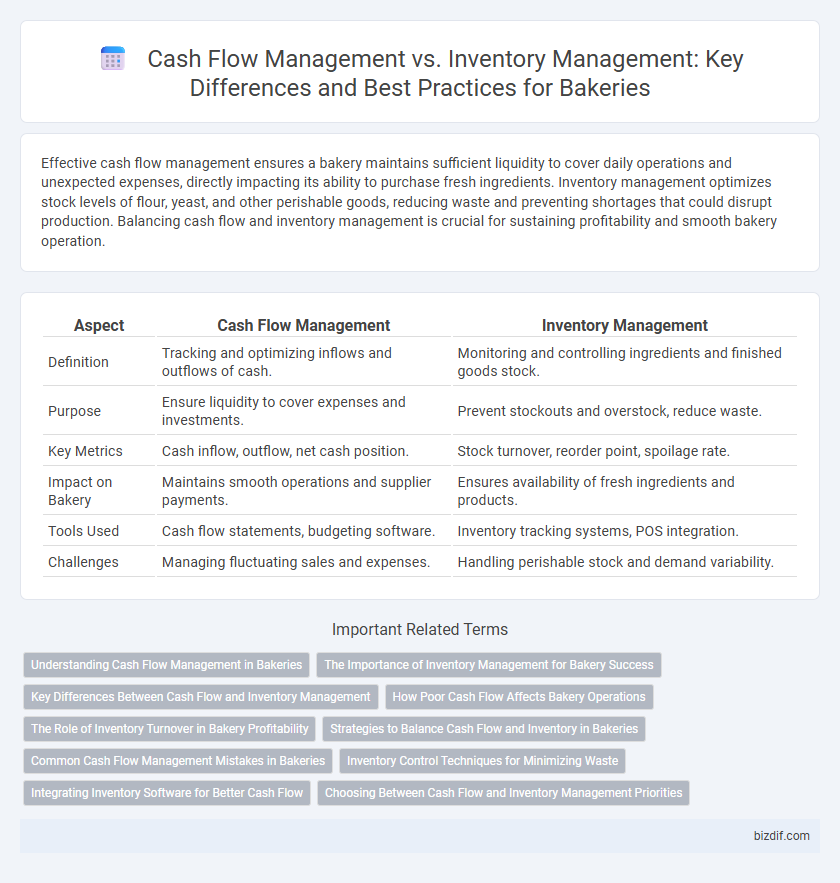Effective cash flow management ensures a bakery maintains sufficient liquidity to cover daily operations and unexpected expenses, directly impacting its ability to purchase fresh ingredients. Inventory management optimizes stock levels of flour, yeast, and other perishable goods, reducing waste and preventing shortages that could disrupt production. Balancing cash flow and inventory management is crucial for sustaining profitability and smooth bakery operation.
Table of Comparison
| Aspect | Cash Flow Management | Inventory Management |
|---|---|---|
| Definition | Tracking and optimizing inflows and outflows of cash. | Monitoring and controlling ingredients and finished goods stock. |
| Purpose | Ensure liquidity to cover expenses and investments. | Prevent stockouts and overstock, reduce waste. |
| Key Metrics | Cash inflow, outflow, net cash position. | Stock turnover, reorder point, spoilage rate. |
| Impact on Bakery | Maintains smooth operations and supplier payments. | Ensures availability of fresh ingredients and products. |
| Tools Used | Cash flow statements, budgeting software. | Inventory tracking systems, POS integration. |
| Challenges | Managing fluctuating sales and expenses. | Handling perishable stock and demand variability. |
Understanding Cash Flow Management in Bakeries
Effective cash flow management in bakeries involves closely monitoring daily sales, ingredient expenses, and labor costs to maintain financial stability. Unlike inventory management, which tracks stock levels and order cycles of flour, sugar, and other baking essentials, cash flow management ensures that the bakery has sufficient liquid assets to cover operational expenses. Prioritizing cash flow allows bakery owners to avoid disruptions in production and capitalize on growth opportunities by managing receivables and payables efficiently.
The Importance of Inventory Management for Bakery Success
Effective inventory management is crucial for bakery success as it ensures the availability of fresh ingredients, minimizes waste, and maintains product quality, directly impacting cash flow. Proper tracking of inventory levels helps bakeries avoid overstocking expensive perishable items and reduces spoilage costs. Streamlined inventory management supports consistent production schedules and timely fulfillment of customer orders, enhancing overall profitability.
Key Differences Between Cash Flow and Inventory Management
Cash flow management in a bakery focuses on monitoring the inflow and outflow of cash to ensure sufficient liquidity for daily operations, while inventory management tracks raw materials and finished goods to maintain optimal stock levels. Cash flow involves budgeting for expenses like ingredient purchases and payroll, whereas inventory management emphasizes reducing waste and preventing stockouts of key products such as flour, yeast, and baked goods. Effective coordination between cash flow and inventory management improves profitability by balancing financial resources with production demands.
How Poor Cash Flow Affects Bakery Operations
Poor cash flow in a bakery cripples the ability to purchase essential ingredients such as flour, yeast, and dairy, leading to production delays and inconsistent product availability. Insufficient funds hinder timely payroll payments and equipment maintenance, which damages employee morale and increases the risk of costly breakdowns. These challenges disrupt inventory management, causing stockouts or excessive spoilage that further strain financial resources and weaken overall bakery operations.
The Role of Inventory Turnover in Bakery Profitability
Inventory turnover plays a crucial role in bakery profitability by directly impacting cash flow management and operational efficiency. High inventory turnover ensures freshness of baked goods, reduces waste, and optimizes ingredient purchasing cycles, leading to improved profit margins. Effective monitoring of turnover rates allows bakeries to balance stock levels and meet customer demand without tying up excessive capital in inventory.
Strategies to Balance Cash Flow and Inventory in Bakeries
Effective cash flow management in bakeries requires aligning inventory purchases with sales cycles to avoid overstocking perishable ingredients. Implementing just-in-time inventory strategies minimizes waste while ensuring sufficient stock levels for peak demand periods. Leveraging sales forecasting tools and real-time inventory tracking enables bakery owners to balance cash reserves and ingredient turnover efficiently.
Common Cash Flow Management Mistakes in Bakeries
Common cash flow management mistakes in bakeries include overstocking inventory, which ties up capital and increases waste due to perishability, and neglecting proper cash flow forecasting, leading to unexpected shortfalls during slow sales periods. Poor separation of personal and business expenses can obscure true financial health, while failing to track daily sales accurately disrupts timely payment of suppliers and payroll. Effective cash flow management requires balancing inventory turnover with sales velocity to maintain liquidity without sacrificing product availability.
Inventory Control Techniques for Minimizing Waste
Effective inventory control techniques in bakery operations, such as just-in-time stock replenishment and first-in, first-out (FIFO) rotation, significantly minimize waste and optimize freshness. Regular inventory audits and demand forecasting help manage perishable ingredients, reducing spoilage and overstock costs. Integrating inventory management with cash flow monitoring ensures balanced purchasing decisions and sustained financial health.
Integrating Inventory Software for Better Cash Flow
Integrating inventory software in a bakery streamlines stock tracking and reduces waste, directly improving cash flow management by minimizing excess inventory costs. Real-time data from inventory systems enables accurate demand forecasting, ensuring timely purchases and optimal ingredient usage. This integration supports better financial planning, enhancing profitability and operational efficiency in bakery management.
Choosing Between Cash Flow and Inventory Management Priorities
Balancing cash flow management and inventory management is crucial for bakery profitability, as cash flow ensures daily operational liquidity while inventory management prevents overstocking and waste of perishable goods. Prioritizing cash flow helps maintain supplier payments and payroll, but efficient inventory tracking minimizes spoilage costs and ensures fresh product availability. An integrated approach using sales forecasting and real-time inventory data optimizes both cash reserves and stock levels, supporting sustained bakery growth.
Cash Flow Management vs Inventory Management Infographic

 bizdif.com
bizdif.com